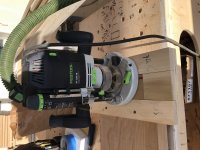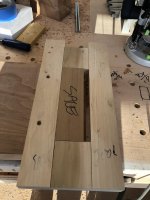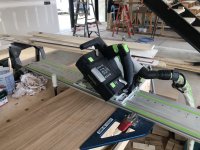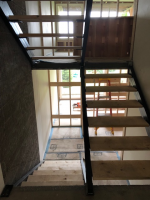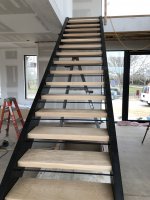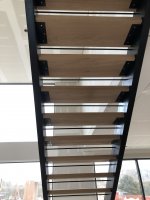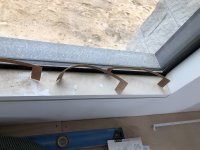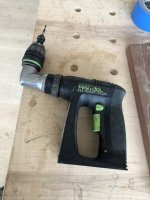You are using an out of date browser. It may not display this or other websites correctly.
You should upgrade or use an alternative browser.
You should upgrade or use an alternative browser.
White Oak and Steel Stair
- Thread starter glass1
- Start date
Cheese
Member
I also like it...nice job.
Are you inleting the treads to fit flush with the brackets?
Are you inleting the treads to fit flush with the brackets?
PeterJJames13
Member
- Joined
- Jul 18, 2018
- Messages
- 258
Looks really great. Was that cut with a Kapex by any chance??? [dead horse] [poke]
PeterJJames13 said:Looks really great. Was that cut with a Kapex by any chance??? [dead horse] [poke]
I heard it was just the first 3 treads
glass1 said:Yes the of 2200 is dadoing out the bottom of each tread so the brackets are flush to the bottom of the tread. The rod is to reduce the space to less tha 4”. Which is the baby head code.
I just did shop drawings and install on a similar project but glulam treads were used which were thick enough to keep the babes heads out. 6 floors, none square, level to each other. Shown are temp. 2x treads.
Attachments
DeformedTree
Member
- Joined
- May 19, 2018
- Messages
- 1,397
glass1 said:Yes the of 2200 is dadoing out the bottom of each tread so the brackets are flush to the bottom of the tread. The rod is to reduce the space to less tha 4”. Which is the baby head code.
I love how in some magazines it seams like every house has a staircase in violation of this code (and many more). I like this solution, it ties in well.
Mario Turcot
Member
- Joined
- Nov 26, 2017
- Messages
- 1,288
[member=4687]glass1[/member]
To attach multiple images to a single post, click on the label that says (more attachments)
glass1 said:No kapex. Tsc 55 with rail and two square. I will post more pic bunt the site will only allow me to upload 1 picture at a time.
To attach multiple images to a single post, click on the label that says (more attachments)
Attachments
Some side pictures of some off cuts from the treads. I had made all the treads tight when the architect announce he wanted a 3/32 reveal between the treads at the stringer so Had to make some shave cuts with the tsc55 and tso +guide rail. And of course old faithful that’s never let me down. Only one battery will still take a charge. I may have to revisit those Festool drills. If one considers how long they last their price is more tolerable.
Attachments
Cheese
Member
So you had to dado both the tread edge and the tread bottom to inlet for the welded brackets. [smile]
I wonder what that 3/32" reveal will look like in 5 years on a sunny day?
5 years to collect dirt, cookie crumbs, dog fur & cat hair. [tongue]
Really nice job. [cool]
And the TSC has more power than the TS.
I wonder what that 3/32" reveal will look like in 5 years on a sunny day?
5 years to collect dirt, cookie crumbs, dog fur & cat hair. [tongue]
Really nice job. [cool]
And the TSC has more power than the TS.
The stair is looking great and will only improve when the finish goes on the white oak.
The stair reminds me of a design I saw where the treads were about half the thickness of the ones in this stair. Each tread had three pegs drilled into the bottom of each tread protruding downwards about 4 inches. These pegs had a hole drilled in them that the rod like in your stair passed through. The rod was smooth in the center and had threads cut on the ends. This hole was slightly further down from the bottom of the tread than the holes in the stringers. This allows when the rod is tensioned to pull up on the middle of the tread. The center peg was straight down and the two offset pegs angled slightly towards the stringer. These pegs were sculpted out of a contrasting hardwood, so not just a round peg. I have tried to find the article but have been unable to do so. Hope my explanation makes sense? I have been looking for a job to incorporate the design into but never found one.
I agree with Cheese on the 3/32 gap. I prefer either a space big enough to clean easily or dead tight but telling the architect his idea did not make any sense never worked out well for me Best to just build as drawn.
Best to just build as drawn.
The stair reminds me of a design I saw where the treads were about half the thickness of the ones in this stair. Each tread had three pegs drilled into the bottom of each tread protruding downwards about 4 inches. These pegs had a hole drilled in them that the rod like in your stair passed through. The rod was smooth in the center and had threads cut on the ends. This hole was slightly further down from the bottom of the tread than the holes in the stringers. This allows when the rod is tensioned to pull up on the middle of the tread. The center peg was straight down and the two offset pegs angled slightly towards the stringer. These pegs were sculpted out of a contrasting hardwood, so not just a round peg. I have tried to find the article but have been unable to do so. Hope my explanation makes sense? I have been looking for a job to incorporate the design into but never found one.
I agree with Cheese on the 3/32 gap. I prefer either a space big enough to clean easily or dead tight but telling the architect his idea did not make any sense never worked out well for me
Similar threads
- Replies
- 21
- Views
- 22K
- Replies
- 2
- Views
- 206


